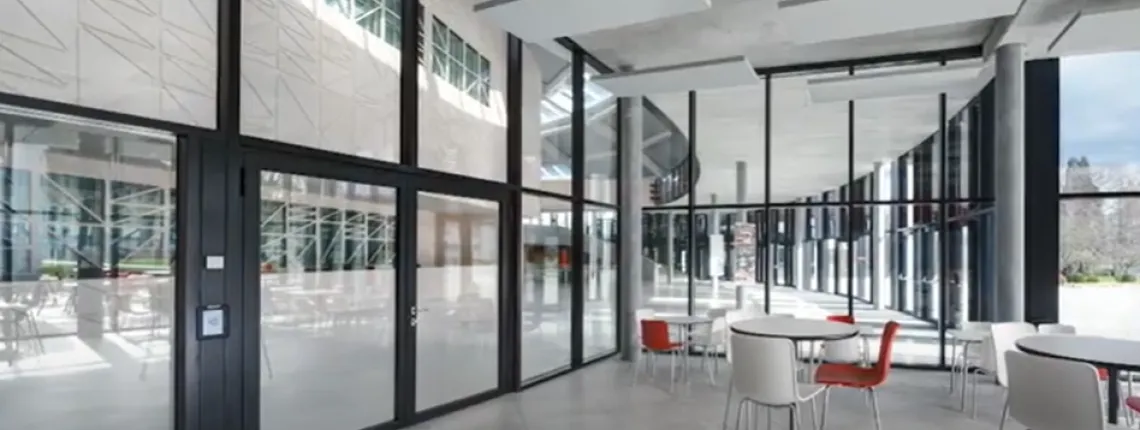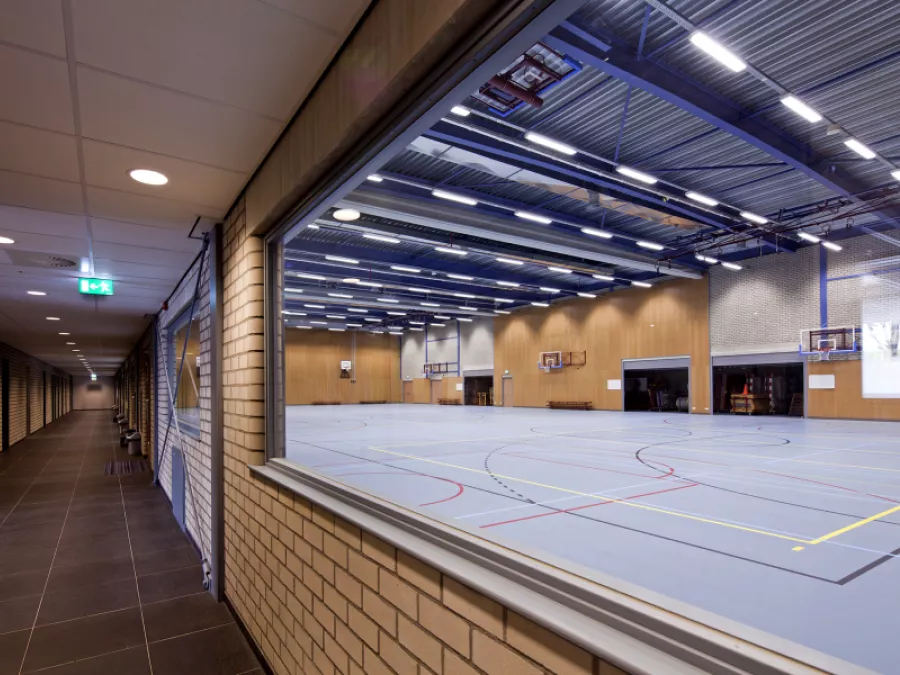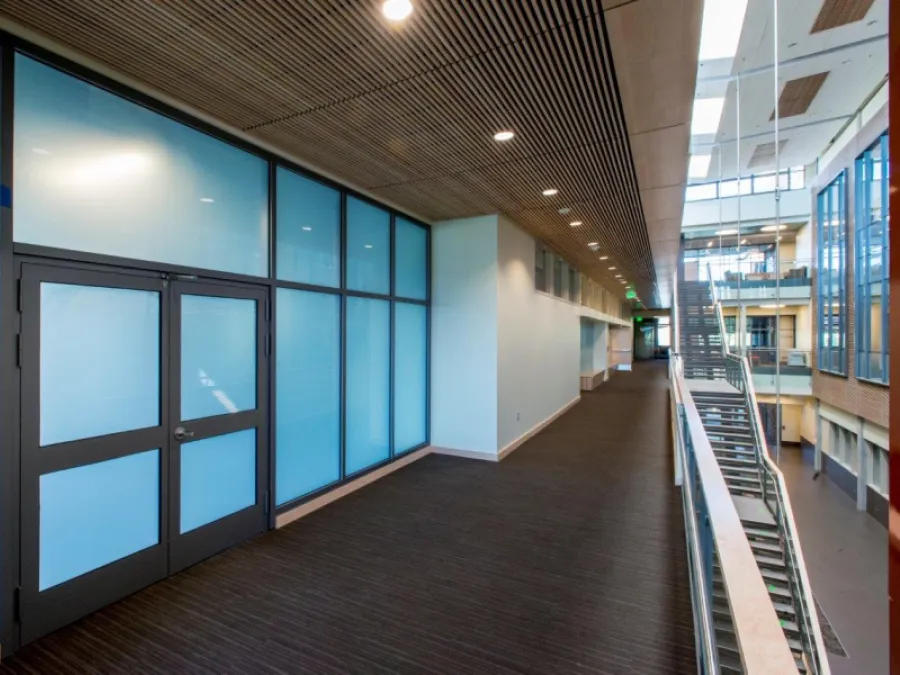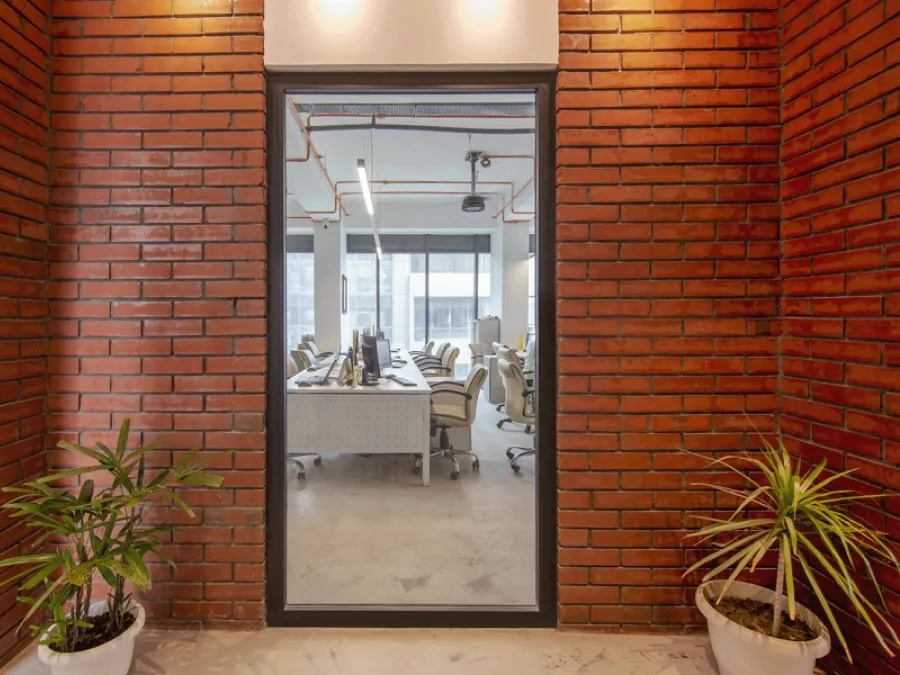The Importance of Installing Fire-Rated Glass in Public Spaces

Public spaces like malls, airports, metros and schools attract large crowds, making fire safety a top priority. Fire-rated glass plays a critical role in enhancing safety by preventing the spread of flames and smoke, giving occupants more time to evacuate. Beyond protection, it also maintains transparency and natural light, blending safety with aesthetics. By integrating fire-resistant glass solutions into public spaces and by incorporating fire-resistant glass, building owners can meet stringent safety regulations while enhancing occupant comfort, visibility, and overall building aesthetics.

What is Fire-Rated Glass?
Fire-rated glass is specially designed to withstand high temperatures and prevent the spread of flames and smoke. It maintains structural integrity during a fire, ensuring safe evacuation routes and preventing heat transfer. Unlike standard glass, which can shatter under slight heat, fire-resistant glass remains intact as it undergoes rigorous testing to meet international safety standards, making it a reliable choice for public buildings.
The Role of Fire Glass in The Safety of Buildings
Fire safety glasses provide an additional layer of protection by containing the spread of smoke and heat. Their advanced composition ensures that they resist heat for extended periods, safeguarding both lives and property.
Key Benefits of Fire-Resistant Glass Installation in Public Spaces
Incorporating these glass systems into public spaces offers numerous advantages. While their primary function is to contain flames and smoke, they seamlessly balance fire protection with aesthetics, ensuring that public spaces remain secure without compromising natural light, acoustic performance, or thermal efficiency.
Enhanced Fire Protection and Safety
Fire-rated glass installation effectively compartmentalize fire in the fire zone, slowing its spread and allowing safer evacuation. By preventing the rapid movement of flames and smoke, these systems provide crucial protection, ensuring that evacuation routes remain secure and accessible.
Unobstructed Visibility and Natural Light
Unlike traditional fire barriers, this glass maintains clear visibility and allows natural light to pass through, creating bright, open spaces. In normal conditions, this transparency contributes to an inviting and well-lit environment, enhancing occupant comfort while maintaining the aesthetics of public buildings.
Improved Acoustic and Thermal Insulation
Modern fire-rated glass systems can also offer superior acoustic insulation, reduce noise pollution and provide better thermal efficiency. These systems ensure a quieter indoor environment and enhance energy efficiency. This results in a more comfortable space for building occupants.
Regulatory Compliance for Fire-Rated Glass Systems in Public Spaces
Ensuring the safety of occupants in public spaces goes beyond installing fire-rated glass systems. It requires strict adherence to local and international fire safety regulations.

Applications of Fire-Rated Glass in Public Spaces
The fire rated glass plays a crucial role in enhancing fire safety across various public spaces where large crowds gather. From ensuring secure evacuation routes to maintaining structural stability, these systems protect lives and property. Their effectiveness extends across multiple sectors, making them an essential component of modern fire safety strategies.
1. Malls and Shopping Complexes
Malls and shopping complexes attract large crowds daily, which increases the likelihood of potential safety hazards due to high foot traffic and diverse activities. Fire-resistant glass in these environments slows the spread of fire and smoke, giving occupants more time for safe evacuation and reducing potential damage.
In addition, integrating smoke barrier systems enhances overall fire safety by containing smoke in specific areas, reducing the risk of exposure to toxic fumes and ensuring compliance with safety regulations.
2. Airports and Transportation Hubs
Airports and transportation hubs require robust fire safety measures to protect passengers and infrastructure during emergencies. Fire-resistant glazing enhances security by maintaining secure evacuation routes and ensuring the structural integrity of these facilities during emergencies.
These glass systems protect against fire hazards and provide increased resistance to physical impact, making them ideal for high-risk areas.
3. Educational Institutions
Schools, colleges, and universities must prioritise the safety of students, faculty, and staff. Fire-rated glass installation in these institutions creates secure learning environments by containing fire and smoke.
Additionally, these glass systems improve visibility and natural light transmission, contributing to a more comfortable and conducive learning atmosphere.
4. Hospitals
Hospitals and healthcare facilities house vulnerable populations, making fire safety necessary. The installation of these glasses in critical areas such as emergency rooms, ICUs, and corridors ensures the containment of fire and smoke, protecting both patients and medical staff.
These systems provide an added layer of safety while maintaining a sterile and controlled environment essential for healthcare operations.

Why Fire-Resistant Glass Is Essential for Modern Architecture
Modern architecture emphasises open, light-filled spaces that balance aesthetics and safety. Fire-rated glazing systems achieve this balance by maintaining visual openness while providing critical fire protection. They also enhance overall building safety, improve acoustic insulation, and boost thermal efficiency, ensuring greater occupant comfort.
Vetrotech Design Solutions (VDS) plays a pivotal role in achieving this balance by offering advanced fire-rated glass systems that seamlessly integrate into modern architectural designs. VDS systems combine high-performing steel frames with certified fire-resistant glass, ensuring superior protection without compromising aesthetics.
Their multifunctional performance makes them an ideal choice for architects who seek safety, design flexibility, and compliance with stringent safety standards—all in one system.
Factors to Consider When Choosing Fire-Rated Glass
Selecting the right fire-rated glass ensures optimal safety and performance in public spaces. Beyond meeting fire safety requirements, it is crucial to assess factors such as fire resistance levels, compliance with safety standards, and the specific needs of the building environment.
Careful evaluation ensures that the chosen solution provides maximum protection while maintaining functionality and aesthetics.
1. Fire Resistance Rating
Evaluating the fire resistance rating is the first step in selecting fire-rated glass. Ratings such as E (Integrity), EW (Integrity and Radiation Control), and EI (Integrity and Insulation) indicate how long the glass can withstand fire while maintaining its structural integrity.
The appropriate rating should be chosen based on the building’s fire safety requirements and the level of protection needed.
2. Compliance with Safety Standards
Ensuring that the selected glass complies with internationally recognised fire testing standards is critical for maintaining the safety of building occupants. Certifications from accredited laboratories, such as EN or IS standards, validate the glass’s performance in real-world conditions.
Compliance with these standards guarantees that the glass can withstand heat, smoke, and flame for a designated period, meeting the safety requirements for public spaces.
Ensuring Safety and Style with Fire-Resistant Glass
Fire-rated glass systems play a crucial role in safeguarding public spaces while maintaining architectural appeal. By preventing the spread of fire and smoke, these systems ensure occupant safety and compliance with fire safety regulations.
Modern innovations, such as Vetrotech Design Solutions (VDS), allow architects to create spaces that seamlessly blend security, natural light, and design aesthetics. Choosing the right glass enhances both safety and occupant comfort, making it an essential investment for any public building.

